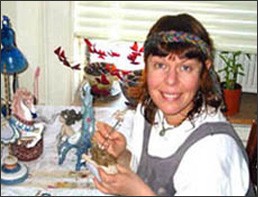Visit Luel Restoration Studio — The Ceramic And Pottery Restoration Experts
We received an e-mail from a client for whom we restored an antique pottery bowl. He lives in Taos, New Mexico and has decided to become a ceramic and porcelain restoration expert himself. Potteryrepair is what he’s interested in and he read as much on the subject as he could get his hands on, including old journals. In his e-mail he outlined his own theory from everything he’s read, and asked us to post it on our blog for those of you who might be interested in investigating the art of pottery and porcelain restoration. Here’s his e-mail:
On Pottery Restoration
The restoration process described here is a pottery restoration technique that can be used in small studio or museum limited in personnel and equipment. It is essential in this process that enough of the vessel be represented to show at least one-third of the curve of rim and body. When related sherds have been mended to form a single piece, the entire surface is covered with liquid soap, or a similar agent, to prevent the plaster of Paris, used as explained later, from adhering to the surface or in the lines of mending. When carefully covered by this film, the piece is placed to stand upright on its rim. Thus the plane of the table on which it rests becomes the plain of the rim, and the angle with this plane assumed by the walls of the vessel accurately determined.
Then plaster for pottery repair, just thin enough to prevent air bubbles, is poured on the surface. The mold should be so made as to be easily removed after hardening. With this precaution observed, the mold may be built up to a thickness sufficient to insure against breakage in handling. It may be necessary to make the mold in two parts, for restoration of pottery depends on the amount of curve characterizing the pottery walls. When the mold has become thoroughly dried, it should be removed with little effort.
Then plaster is poured into the mold to produce a cast of the partial pot. Caution should be observed to make the cast as nearly the thickness of the pottery as possible, and to facilitate the easy removal of the mold. While the cast is drying, the operator may continue his work by finding the circumference of the mouth of the original pot. The outside of the rim is traced on a piece of paper upon which the pottery section is resting, rim down. A flat pencil is used to permit the line to follow the rim more closely. With this done, the pottery is removed from the arc thus projected on the paper. On the arc draw two chords, and upon these chords erect perpendicular bisectors. The radius of the original vessel is the distance from the point of intersection of the bisectors to the arc. The pottery piece is now fixed in erect position, resting on its rim, by driving wire brads to form inner and outer supporting rows. The cast reproduction of the pottery piece is placed on its rim, the latter resting on the line marking the completed circumference, opposite the true sherd.
The next step of the repair is to model in the missing parts of the rim. This can be done in some cases by the application of thick plaster only. It may be necessary to model in clay the remaining spaces between the edges of the two pieces, and then build on either side a plaster mold which will overlap the edges of the pottery and the cast. The modeling clay will reconstruct the shape of the missing pottery, as indicated by the exist- ing parts. Remove the clay after the plaster has hardened. Arrange the mold in a position so that the two pieces will be in their correct relative positions in the new mold, and thus add a cast that will make one solid piece of the original two. In many cases the missing parts of the vessel must be modeled in clay, and molds made, as in previously described instances. If the spaces to be filled are small, this can be effected from the outside by backing the opening with any kind of modeling material, filling in plaster, and finishing before the plaster is too hard.
As always, if your item is valuable, don’t attempt to restore it yourself. Contact Pottery Repair and Restoration experts, such as Luba Sokolina at Luel Restoration Studio. Luba and staff will restore your item quickly and invisibly. Visit the website for Contact Information.


Speak Your Mind